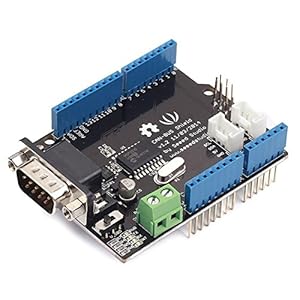#36,577 in Electronics
Use arrows to jump to the previous/next product
Reddit mentions of CAN-BUS Shield Compatible with Arduino and Seeeduino
Sentiment score: 1
Reddit mentions: 1
We found 1 Reddit mentions of CAN-BUS Shield Compatible with Arduino and Seeeduino. Here are the top ones.
or
Implements CAN V2.0B at up to 1 Mb/sSPI Interface up to 10 MHzStandard (11 bit) and extended (29 bit) data and remote framesTwo receive buffers with prioritized message storageIndustrial standard 9 pin sub-D connector, Two LED indicators
Specs:
| Height | 1 Inches |
| Length | 3.8 Inches |
| Weight | 0.1 Pounds |
| Width | 2.7 Inches |

CAN is a very simple protocol. So simple, in fact, that it is basically useless on its own. CAN is a low-level data-link layer that allows you to send frames of eight bytes to a bus. If you want to send messages of more than eight bytes, you need to come up with a way to stitch multiple frames together. If you want node to node communication, you need to decide how each device is addressed and how transactions take place between them. CAN is at the bottom of the protocol stack. For anything useful to happen, you need to add a couple more layers on top of it. Some examples of these higher level protocols include CANopen, DeviceNet, and many others. As an example specific to automotive, ISO-15765-2 is a transport layer that is implemented using a CAN bus. This ISO standard defines how to combine multiple eight byte CAN frames into messages of up to 4095 bytes. Still, ISO-15765-2 is not so useful on its own either. On top of this transport layer sits ISO-15765-3 and ISO-15765-4, and then finally, we arrive at OBDII. Traversing the stack the other way, we can see that the high-level OBDII protocol can be implemented using many sub-protocols, not just ISO-15765. OBDII information can also be carried using SAEJ2284 CAN, UART, and some others.
​
If you want to learn to CAN, I wouldn't recommend starting with literature. You should decide what your goal is first. Do you want to be able to talk to your ECU which is already speaking in some higher level protocol? Do you want to build some custom sensors where you get to decide how the protocol stack looks? Do you want to buy a bunch of ready-to-go CANopen slaves and just implement a master to control those? I would make a couple decisions about what you are trying to accomplish first, then you can take it step by step and visit the specific piece of literature that will help you clear whatever the next hurdle is.
​
In any case, you may want to play around with some hardware just to familiarize yourself with the protocol. If you ever thought about buying this CAN Arduino Shield, don't. Just buy a bunch of these MCP2515 Breakouts that use the exact same hardware and are much cheaper. Hook them up a couple Arduinos and use the MCP2515 library to send some frames back and forth. Once thats done, take those Arduinos and put them into the garbage. Buy a bunch of $2 STM32F103C8T6 Blue pills, a bunch of $2 ST-Link V2 knockoff debuggers, some TJA1050 CAN transceivers, and have an MCU with a built in CAN peripheral that is a magnitude more powerful than an Arduino UNO for a fraction of the cost. Download System Workbench or Atollic TrueStudio and you can open hundreds of example projects and step through the code line by line as it runs in real time on the microcontroller. You can program these blue pills through the Arduino IDE also, but I really encourage serious engineers to move away from the Arduino ecosystem.